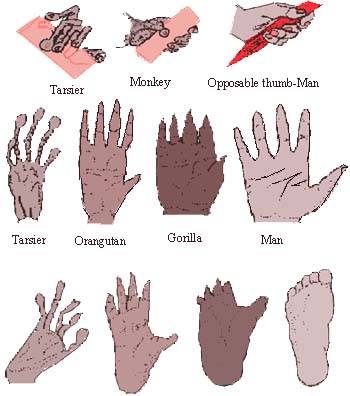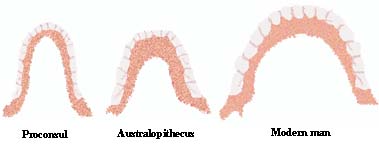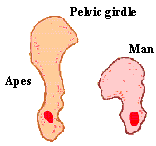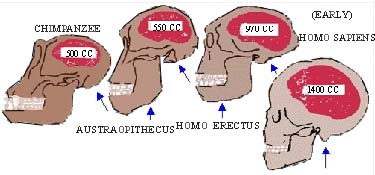|
PinkMonkey Online Study Guide-Biology
(6) Homo sapiens
They first appeared less than 1,00,000 years ago. During
the evolution of Homo sapiens, we have seen that our ancestors
changed from ape to apelike to human-like to human, and thus changed in
several ways. For example
(1) They changed from four-legged to two-legged
posture, became erect and bipedal.
(2) The feet lost their hand like features and became suited for upright walking and running.
(3) The hands became more dexterous, free to manipulate, the thumb became opposable with precision and power grip. (Figure 12.6)
(4) The brains grew larger, and a more creative intelligence
developed.

Figure 12.6 Hands and feet of tarsier, orangutan, gorilla and man
The following evolutionary changes are seen in man:
1. Erect posture.
2. Balancing of head on neck.
3. Vertebral column showing four curvatures. (Figure 12.7 A)
4. Forelimbs shorter than hind limbs.
5. Small jaw and teeth.
6. The dental arches changed shape, all the teeth moved closer together and the canine teeth became shorter (Figure 12.7 B).
7. Manís foot develop into a sturdy support with complete base.
8. The toes shortened and the big toe moved into line with others. The foot became arched.
9. Apes have long, slanting hip girdle. Manís pelvis is short, wide and vertical. It permits erect posture and frees hands for manipulation. (Figure 12.7C)
10. Brain expansion (increased cranial cavity, complex cerebellum and cerebrum) and the use of tools are associated with the human evolution (12.D & E).

Greater curvature of spine in human
Figure 12.7A

Figure 12.7B Change in shape of dental arches

Figure 12.7C Pelvic girdle

Figure 12.7D

Figure 12.7E Changes in the proportion of the skull from
ape to human. Note position of foramen magnum(arrows)
Thus, we find that we are basically the same as our Cro-Magnon ancestors, who lived about 35,000 years ago.
|
SUMMARY
(1) Human beings, Homo sapiens, are primates whose
ancestors were arboreal during the mesozoic era.
(2) The arboreal characters were highly developed
in anthropoid apes, which probably had a common ancestor with
human in species like Dryopithecus during the Pliocene.
(3) The two groups, apes and human ancestors
diverged and the human ancestors gradually adapted for erect,
bipedal locomotion on the open plants.
(4) Further evolution of man revolved around
the use of brain and hands to collect food, to make tools
for hunting, collection and storing of food, colonization,
agriculture and finally to make fires and clothes which permitted
hominids to spread from their original home in Africa.
(5) A common ancestry for a great apes and
man is based on similarities in DNA content, chromosome number
and banding patterns of chromosomes.
|
**********
|
Table of Contents
12.0 Introduction
12.1 Palaeontological Evidences - Our Ancestors
12.2 Ancestral Forms of Homo Sapiens
Chapter
13
|